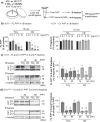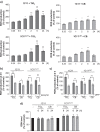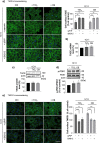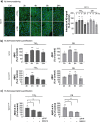Titanium dioxide and carbon black nanoparticles disrupt neuronal homeostasis via excessive activation of cellular prion protein signaling
- PMID: 35840975
- PMCID: PMC9284759
- DOI: 10.1186/s12989-022-00490-x
Titanium dioxide and carbon black nanoparticles disrupt neuronal homeostasis via excessive activation of cellular prion protein signaling
Abstract
Background: Epidemiological emerging evidence shows that human exposure to some nanosized materials present in the environment would contribute to the onset and/or progression of Alzheimer's disease (AD). The cellular and molecular mechanisms whereby nanoparticles would exert some adverse effects towards neurons and take part in AD pathology are nevertheless unknown.
Results: Here, we provide the prime evidence that titanium dioxide (TiO2) and carbon black (CB) nanoparticles (NPs) bind the cellular form of the prion protein (PrPC), a plasma membrane protein well known for its implication in prion diseases and prion-like diseases, such as AD. The interaction between TiO2- or CB-NPs and PrPC at the surface of neuronal cells grown in culture corrupts PrPC signaling function. This triggers PrPC-dependent activation of NADPH oxidase and subsequent production of reactive oxygen species (ROS) that alters redox equilibrium. Through PrPC interaction, NPs also promote the activation of 3-phosphoinositide-dependent kinase 1 (PDK1), which in turn provokes the internalization of the neuroprotective TACE α-secretase. This diverts TACE cleavage activity away from (i) TNFα receptors (TNFR), whose accumulation at the plasma membrane augments the vulnerability of NP-exposed neuronal cells to TNFα -associated inflammation, and (ii) the amyloid precursor protein APP, leading to overproduction of neurotoxic amyloid Aβ40/42 peptides. The silencing of PrPC or the pharmacological inhibition of PDK1 protects neuronal cells from TiO2- and CB-NPs effects regarding ROS production, TNFα hypersensitivity, and Aβ rise. Finally, we show that dysregulation of the PrPC-PDK1-TACE pathway likely occurs in the brain of mice injected with TiO2-NPs by the intra-cerebro-ventricular route as we monitor a rise of TNFR at the cell surface of several groups of neurons located in distinct brain areas.
Conclusion: Our in vitro and in vivo study thus posits for the first time normal cellular prion protein PrPC as being a neuronal receptor of TiO2- and CB-NPs and identifies PrPC-coupled signaling pathways by which those nanoparticles alter redox equilibrium, augment the intrinsic sensitivity of neurons to neuroinflammation, and provoke a rise of Aβ peptides. By identifying signaling cascades dysregulated by TiO2- and CB-NPs in neurons, our data shed light on how human exposure to some NPs might be related to AD.
Keywords: Alzheimer’s disease; Aβ peptides; Nanoneurotoxicity; Nanoparticles; Neuroinflammation; PrPC receptor; Signaling; TNFα receptors.
© 2022. The Author(s).
Conflict of interest statement
The authors declare that they have no competing interests.
Figures








Similar articles
-
PDK1 decreases TACE-mediated α-secretase activity and promotes disease progression in prion and Alzheimer's diseases.Nat Med. 2013 Sep;19(9):1124-31. doi: 10.1038/nm.3302. Epub 2013 Aug 18. Nat Med. 2013. PMID: 23955714
-
Protective role of cellular prion protein against TNFα-mediated inflammation through TACE α-secretase.Sci Rep. 2017 Aug 9;7(1):7671. doi: 10.1038/s41598-017-08110-x. Sci Rep. 2017. PMID: 28794434 Free PMC article.
-
Production of seedable Amyloid-β peptides in model of prion diseases upon PrPSc-induced PDK1 overactivation.Nat Commun. 2019 Aug 1;10(1):3442. doi: 10.1038/s41467-019-11333-3. Nat Commun. 2019. PMID: 31371707 Free PMC article.
-
Cellular prion protein: A co-receptor mediating neuronal cofilin-actin rod formation induced by β-amyloid and proinflammatory cytokines.Prion. 2014;8(6):375-80. doi: 10.4161/pri.35504. Prion. 2014. PMID: 25426519 Free PMC article. Review.
-
The Link of the Prion Protein with Ca2+ Metabolism and ROS Production, and the Possible Implication in Aβ Toxicity.Int J Mol Sci. 2019 Sep 19;20(18):4640. doi: 10.3390/ijms20184640. Int J Mol Sci. 2019. PMID: 31546771 Free PMC article. Review.
Cited by
-
Modulation efficiency of clove oil nano-emulsion against genotoxic, oxidative stress, and histological injuries induced via titanium dioxide nanoparticles in mice.Sci Rep. 2024 Apr 2;14(1):7715. doi: 10.1038/s41598-024-57728-1. Sci Rep. 2024. PMID: 38565575 Free PMC article.
-
Role of cellular prion protein in mouse granulosa cells and its effects on ovarian function in knockout mice.Mol Med Rep. 2025 Oct;32(4):265. doi: 10.3892/mmr.2025.13630. Epub 2025 Jul 25. Mol Med Rep. 2025. PMID: 40709399 Free PMC article.
-
Metallic Nanoparticles Applications in Neurological Disorders: A Review.Int J Biomater. 2025 Jul 6;2025:4557622. doi: 10.1155/ijbm/4557622. eCollection 2025. Int J Biomater. 2025. PMID: 40661692 Free PMC article. Review.
-
Neurotoxicity of Titanium Dioxide Nanoparticles: A Comprehensive Review.Int J Nanomedicine. 2023 Dec 5;18:7183-7204. doi: 10.2147/IJN.S442801. eCollection 2023. Int J Nanomedicine. 2023. PMID: 38076727 Free PMC article. Review.
-
Sleep matters: Neurodegeneration spectrum heterogeneity, combustion and friction ultrafine particles, industrial nanoparticle pollution, and sleep disorders-Denial is not an option.Front Neurol. 2023 Feb 27;14:1117695. doi: 10.3389/fneur.2023.1117695. eCollection 2023. Front Neurol. 2023. PMID: 36923490 Free PMC article. Review.
References
-
- Kaphle A, Navya PN, Umapathi A, Daima HK. Nanomaterials for agriculture, food and environment: applications, toxicity and regulation. Environ Chem Lett. 2018;16:43–58. doi: 10.1007/s10311-017-0662-y. - DOI
Publication types
MeSH terms
Substances
LinkOut - more resources
Full Text Sources
Medical
Research Materials
Miscellaneous

